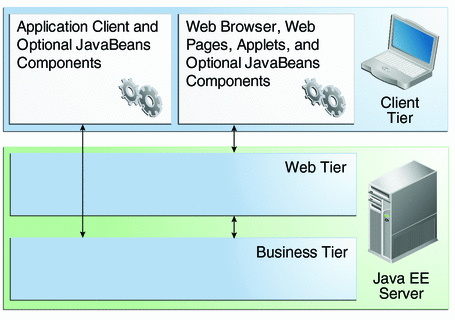Java EE Clients
A Java EE client is usually either a web client or an application client.
Web Clients
A web client consists of two parts:
-
Dynamic web pages containing various types of markup language (HTML, XML, and so on), which are generated by web components running in the web tier
-
A web browser, which renders the pages received from the server
A web client is sometimes called a thin client. Thin clients usually do not query databases, execute complex business rules, or connect to legacy applications. When you use a thin client, such heavyweight operations are off-loaded to enterprise beans executing on the Java EE server, where they can leverage the security, speed, services, and reliability of Java EE server-side technologies.
Application Clients
An application client runs on a client machine and provides a way for users to handle tasks that require a richer user interface than can be provided by a markup language. An application client typically has a graphical user interface (GUI) created from the Swing or the Abstract Window Toolkit (AWT) API, but a command-line interface is certainly possible.
Application clients directly access enterprise beans running in the business tier. However, if application requirements warrant it, an application client can open an HTTP connection to establish communication with a servlet running in the web tier. Application clients written in languages other than Java can interact with Java EE servers, enabling the Java EE platform to interoperate with legacy systems, clients, and non-Java languages.
Applets
A web page received from the web tier can include an embedded applet. Written in the Java programming language, an applet is a small client application that executes in the Java virtual machine installed in the web browser. However, client systems will likely need the Java Plug-in and possibly a security policy file for the applet to successfully execute in the web browser.
Web components are the preferred API for creating a web client program, because no plug-ins or security policy files are needed on the client systems. Also, web components enable cleaner and more modular application design because they provide a way to separate applications programming from web page design. Personnel involved in web page design thus do not need to understand Java programming language syntax to do their jobs.
The JavaBeans Component Architecture
The server and client tiers might also include components based on the JavaBeans component architecture (JavaBeans components) to manage the data flow between the following:
-
An application client or applet and components running on the Java EE server
-
Server components and a database
JavaBeans components are not considered Java EE components by the Java EE specification.
JavaBeans components have properties and have get and set methods for accessing the properties. JavaBeans components used in this way are typically simple in design and implementation but should conform to the naming and design conventions outlined in the JavaBeans component architecture.
Java EE Server Communications
Figure 1–2 shows the various elements that can make up the client tier. The client communicates with the business tier running on the Java EE server either directly or, as in the case of a client running in a browser, by going through web pages or servlets running in the web tier.
Figure 1–2 Server Communication

- © 2010, Oracle Corporation and/or its affiliates
